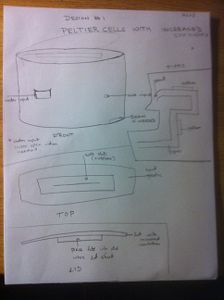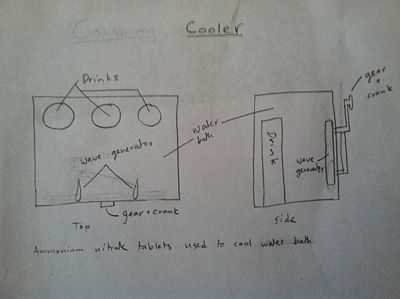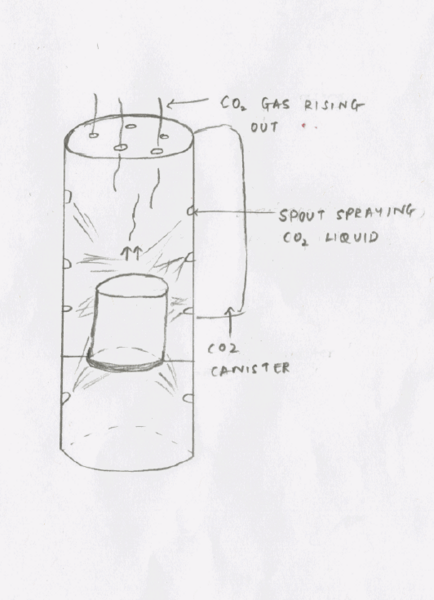Drink cooler opportunity
From DDL Wiki
| Line 41: | Line 41: | ||
The goal of this design was to create a cooling device that did not require access to electricity or ice. Two specific instances where such a product could be handy is a beach of camping trip. This design is basically a water bath that would get cold using a chemical reaction with a mechanical attachment that would create waves in the water to increase forced convection. The chemical reaction used would be the dissolution of ammonium nitrate, which is the same reaction used in cooling ice packs. The mechanical wave maker would be mounted on one side of the product and would generate waves in the ice bath using a gear/crank system that would have to be operated by the user. | The goal of this design was to create a cooling device that did not require access to electricity or ice. Two specific instances where such a product could be handy is a beach of camping trip. This design is basically a water bath that would get cold using a chemical reaction with a mechanical attachment that would create waves in the water to increase forced convection. The chemical reaction used would be the dissolution of ammonium nitrate, which is the same reaction used in cooling ice packs. The mechanical wave maker would be mounted on one side of the product and would generate waves in the ice bath using a gear/crank system that would have to be operated by the user. | ||
| - | |||
| - | |||
| - | |||
| - | |||
| - | |||
| - | |||
| - | |||
| - | |||
| - | |||
| - | |||
| - | |||
| - | |||
| - | |||
| - | |||
| - | |||
| - | |||
| - | |||
| - | |||
===Relevant Patents=== | ===Relevant Patents=== | ||
| Line 67: | Line 49: | ||
==Design Concept 3: Single Phase Spray Cooler== | ==Design Concept 3: Single Phase Spray Cooler== | ||
| - | [[Image:Team4_Design3.png | | + | [[Image:Team4_Design3.png | 800x600px]] |
In the Single-Phase spray cooler, liquid carbon-dioxide is sprayed onto the beverage through the spouts as shown in the figure. | In the Single-Phase spray cooler, liquid carbon-dioxide is sprayed onto the beverage through the spouts as shown in the figure. | ||
Revision as of 14:56, 27 February 2012
Contents |
Executive Summary
Market Research
Market research was conducted focusing on the needs and interests of the users. The four methods used were: user interview, user observation, user reviews, and surveys.
User Interview
Users were interviewed to get a better understanding of their opinions on the product. The general consensus was that requirement of ice was a significant constraint to the usability of the product. Loading and changing ice into the device was time-consuming and clumsy. Also, a larger cooling capacity (multiple drinks at once) was desired. With the current one drink limit, this cooling method was not much more efficient than the alternative of an ice-water bath, which could be used to cool multiple drinks at once. The one drink limit also meant that somebody always has to constantly be operating the device in order to cool enough drinks. The noise generated by the device was also a problem. It made holding conversations in the same room as the device uncomfortable. The host has resorted to placing the device in another room when using. This is an idea that we hope to consider in our design.
In summary, the users felt that the current product had limited use. The requirement of ice and low capacity made it marginally better at cooling beverages than an ice bath yet more of a hassle. The noise didn't help. This made the device only practical for cooling 1-2 drinks at a time. One user suggested developing a product that doesn't need ice and marketing the product for a situation where users would not have access to a refrigerator.
User Observation 1
A mock scenario was developed that would imitate the typical anticipated use of the drink cooler. In this scenario, the host was having an impromptu gathering on a weekend night with 5-6 guests. Unfortunately, the host usually did not have space in the refrigerator to keep drinks cool at all time and only had access to room temperature beer. However, he did have the drink cooler and three trays of ice at his disposal. The observations are summarized below.
The drink cooler had a fairly intuitive design. The users had never used the device before and were able to use it within five minutes. Their first instinct was to pour the beer into the ice-water bath. However, they did decided to scan (not read) the instruction manual. This was sufficient to show them the correct way of using the device. Upon setting up the device, they realized that power cord was too short. The only flat surface within reach of the cord was the sofa, which was not a sturdy surface.
They then started to chill their drinks. However, this proved to be a slow process. People started to get restless waiting for their turn to cool their drink. This was especially a problem because most people preferred to drink the glass drink, which takes longer to cool. Eventually, people started just drinking warm beer. This problem could have been reduced had the users fully read the instruction manual. They consistently set their drinks to cool on the higher setting, which isn't necessary for most beverages. Four minutes would have been sufficient for the glass bottles two minutes for the metal cans. This information should be presented more prominently.
Several problems were discovered during the usage of the device. First, it was a very loud machine. People were forced to speak louder then usual and the television volume was had to be turned up. This is obviously not an ideal scenario. Second, the lid did not function well. On some occasions it would pop open while the device was running. Other times, it would take several tries to open. Third, the water proofing on the lid was weak as water dripped out constantly. A cardboard box had to be placed underneath to soak the water. Finally, changing the water was a hassle. This task is hard to do with just one person. The lid does not open fully, forcing the user to tilt the device at awkward angles to get the ice out. Pouring in new water is also a hassle for the same reason.
User Observation 2
The scenario observed in this situation was slightly different. A couple users had just returned from the store having bought beverages on a weekend evening. They wanted to drink a beer each, but it was all at room temperature from the store. They used the drink cooler to cool two beverages for themselves. The observations are summarized below.
Setting up the device was easy. Ice was readily available. The device was started. Again, similar to the previous experience, the device was excessively loud. The two users had to raise their voices to communicate with each other. After usage was done, emptying the ice-water from the device was a hassle. People decided to leave it set up as it is. It remained on the table taking up space for some time.
User Reviews
Survey
Summary
Design Concepts
Design Concept 1
Design Concept 2: Wave Generating
The goal of this design was to create a cooling device that did not require access to electricity or ice. Two specific instances where such a product could be handy is a beach of camping trip. This design is basically a water bath that would get cold using a chemical reaction with a mechanical attachment that would create waves in the water to increase forced convection. The chemical reaction used would be the dissolution of ammonium nitrate, which is the same reaction used in cooling ice packs. The mechanical wave maker would be mounted on one side of the product and would generate waves in the ice bath using a gear/crank system that would have to be operated by the user.
Relevant Patents
Endothermic Beverage Cooler (US 20080271476): Containers with walls made out of an endothermic reaction salt that can be catalyzed when desired cooling the beverages inside the container.
Self-Cooling Containers of Beverage and Foodstuffs (US 6103280): A self-cooling drink container that is made out of an endothermic reaction salt. The reaction is catalyzed by the opening of the beverage due to the carbonation.
Design Concept 3: Single Phase Spray Cooler
In the Single-Phase spray cooler, liquid carbon-dioxide is sprayed onto the beverage through the spouts as shown in the figure. Since, liquid carbon-dioxide has a low boiling point of -70 ͦ F, its boils off on coming in contact with the beverage. The coolant absorbs the heat for boiling from the beverage and chills it instantly. The gas that forms can escape through the openings on the top of the device. Some of the gas may dissolve in the water on the beverage’s container. However, since the carbonic acid formed is not dangerous to consume, no health hazards are posed by the dissolution of carbon-dioxide in water.
The key areas of improvement over the competitor’s product are the following:
1)Reduction in noise and vibrations 2)Faster cooling mechanism 3)A ‘cooler’ design concept 4)Can be used to cool open drinks
However, several drawbacks such as the complexity of design, higher costs of production and use, lack of team interest, prevented us from adopting this concept.
Pugh Chart
The Pugh Chart was used to analyze the feasibility of 10 potential designs. Categories we chosen and weights were assigned to each category. Each of the potential designs was then assessed a score from -2 to +2 relative to the Cooper Cooler Drink Chiller. A +2 was the best and -2 was the worst.
Based on these results, we chose to focus on five Design Concepts which we analyzed further to come to our final design. A brief explanation is given about each of the five designs that were not chosen for the top five design concepts is given below.
Original Design with Chemical Cooling: Same mechanical set up as the original product but will us an ammonium nitrate reaction tablet to cool the water bath. A new table will have to be used each sitting.
Single Chamber with Evaporating Fluid: A coolant fluid would be sprayed onto the container and would evaporate quickly while cooling the drink at the same time.
Single Chamber with Two-Stage Cooling: A liquid coolant would be sprayed onto the drink, which would cool it. Then water would be sprayed on to the drink to remove coolant from sides.
Original Design with Vapor Compression Cycle: Same mechanical setup as original product but would incorporate a vapor compression cycle to cool the water bath, eliminating the need for ice.
Conduction Chamber: A metal chamber that would be designed like a spiral such that it can fit snugly around a drink. The metal would have wires inside the metal that would cool the metal.
Mass Cooling with Nitrogen: Time released nitrogen would be sprayed into an air chamber surrounding a large liquid storage device, such as a keg. This would ideally keep the drink sufficiently cool. After many uses the nitrogen would have to be refilled.
| Category | Weight | Competitor Product | Original w/ Chemical Cooling | Container w/ Waves | Single Chamber w/ Evaporating Fluid | Single Chamber w/ 2-Stage | Original w/ Thermoelectric Cooling | Original w/ Vapor Compression | Conduction Chamber | Mass cooling w/ Nitrogen | Blender Product Mix | Multiple drink, rotating Chamber |
| Initial Cost | 1 | 0 | 0 | 1 | -2 | -2 | -1 | -2 | -2 | -1 | -2 | -2 |
| Recurring Cost | 2 | 0 | -2 | -1 | -1 | 0 | 1 | 1 | 1 | 1 | 0 | 0 |
| Speed of Cooling | 2 | 0 | 1 | -1 | 2 | 1 | 0 | 0 | 1 | 2 | -1 | 1 |
| Portability | 3 | 0 | 1 | 1 | -1 | -2 | 1 | -1 | -2 | -2 | 0 | -2 |
| Ease of Use | 3 | 0 | 1 | -2 | 0 | 0 | 1 | 1 | 0 | 0 | -1 | -1 |
| Low Disruption | 2 | 0 | 0 | -1 | 1 | 1 | 0 | -1 | -1 | 1 | 0 | 0 |
| Team Skill | 3 | 0 | 0 | 2 | 0 | -1 | 1 | 0 | -2 | -2 | 1 | 1 |
| Team Interest | 3 | 0 | 0 | 1 | 0 | -1 | 1 | -2 | -2 | -2 | -1 | -1 |
| Safety | 1 | 0 | -1 | -1 | -1 | -1 | 0 | -1 | -1 | -1 | -1 | 0 |
| Coolness | 1 | 0 | 1 | -1 | 2 | 2 | 0 | 1 | 1 | 2 | 1 | 2 |
| Complexity | 2 | 0 | 0 | 2 | -1 | -2 | -1 | -2 | -2 | -2 | -1 | -2 |
| Total Score: | 0 | 4 | 2 | 0 | -11 | 12 | -10 | -20 | -13 | -7 | -9 | |



